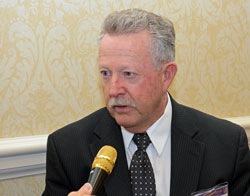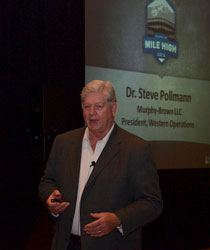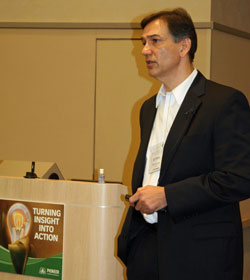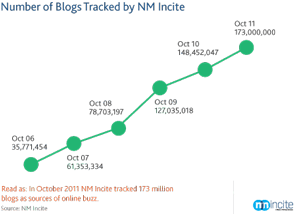Weeds were a big topic of concern for farmers who visited the BASF Crop Protection exhibit at Commodity Classic this year and with planting season now upon us and commodity prices looking good, growers are really looking to control those yield-robbers.
In soybeans, early-season weed competition poses a potential 6 to 10 percent yield loss. In corn, weeds allowed to reach 4 to 6 inches in height can reduce yield potential by 3 percent and 7 percent, respectively. The potential losses due to weeds total almost $10 billion, based on current national projected yields and commodity prices.
 BASF Soybean Market Manager Bryan Perry says from his conversations with growers this year, the big issue is weed resistance management. “We’ve launched a couple of new products, like OpTill PRO this year, to help manage resistance. But keeping weeds out of the field at any point helps maximize yield.”
BASF Soybean Market Manager Bryan Perry says from his conversations with growers this year, the big issue is weed resistance management. “We’ve launched a couple of new products, like OpTill PRO this year, to help manage resistance. But keeping weeds out of the field at any point helps maximize yield.”
The warm winter is causing fields to green up earlier, which will make burn down more important for some growers going into planting. “We launched Kixor® herbicide technology a couple years ago, great burn down, and OpTill PRO has Kixor in it, plus two other sites of action, so you’ve got a product that burns down the weeds and has phenomenal residual to keep them from coming back.”
Listen to or download an interview with Bryan here: BASF Soybean Market Manager Bryan Perry
 BASF Corn Market Manager Mike Hofer says he talked with southern farmers at Classic who expected to start planting the following week, but they too were concerned about weed resistance. “Farmers continue to tell us that they’re battling more weeds that have developed resistance to multiple herbicides that farmers have used over time,” Mike said. “We just recently launched Armezon™, which is a new HPPD inhibitor, and it essentially controls those tough broadleaf weeds post-emerge in corn. It’s unique because it is safe to all types of corn varieties.”
BASF Corn Market Manager Mike Hofer says he talked with southern farmers at Classic who expected to start planting the following week, but they too were concerned about weed resistance. “Farmers continue to tell us that they’re battling more weeds that have developed resistance to multiple herbicides that farmers have used over time,” Mike said. “We just recently launched Armezon™, which is a new HPPD inhibitor, and it essentially controls those tough broadleaf weeds post-emerge in corn. It’s unique because it is safe to all types of corn varieties.”
Mike notes that BASF offers several different programs to help farmers called the Grower Advantage offers. “We have a really unique offer this year that we’re calling Investment Advantage for growers that purchase a high yield package,” Mike says. “If they purchase that by March 15 and commodity prices significantly decline into harvest time, BASF would offer a partial refund on the purchase of those products. It’s the first time that a company is partnering with growers to help them manage risk after they purchase crop protection products.”
Investment Advantage has a March 15 deadline, but there is still time to participate in BASF’s other offers, including Headline Advantage, Finance Advantage and Insurance Advantage. Information on all BASF Grower Advantage offers is available at growersadvantage.basf.us.
Listen to or download an interview with Mike here: BASF Corn Market Manager Mike Hofer
2012 BASF Science Behind Photo Album
 During Commodity Classic I got to visit with Terry Swanson, Chairman, National Sorghum Producers. I asked him what his message is to not only sorghum producers but all the farmers belonging to the four commodity groups at Classic and he says, “We have to be unified.” He says that altogether they’re still a small group of people that need to speak with one voice.
During Commodity Classic I got to visit with Terry Swanson, Chairman, National Sorghum Producers. I asked him what his message is to not only sorghum producers but all the farmers belonging to the four commodity groups at Classic and he says, “We have to be unified.” He says that altogether they’re still a small group of people that need to speak with one voice. 

 At the
At the  During the recent Pioneer Hi-Bred media event, “Turning Insight Into Action,” Chet Holingshead visited with Steve Mirshak, Global Business Director for
During the recent Pioneer Hi-Bred media event, “Turning Insight Into Action,” Chet Holingshead visited with Steve Mirshak, Global Business Director for  BASF Soybean Market Manager Bryan Perry says from his conversations with growers this year, the big issue is weed resistance management. “We’ve launched a couple of new products, like OpTill PRO this year, to help manage resistance. But keeping weeds out of the field at any point helps maximize yield.”
BASF Soybean Market Manager Bryan Perry says from his conversations with growers this year, the big issue is weed resistance management. “We’ve launched a couple of new products, like OpTill PRO this year, to help manage resistance. But keeping weeds out of the field at any point helps maximize yield.”  BASF Corn Market Manager Mike Hofer says he talked with southern farmers at Classic who expected to start planting the following week, but they too were concerned about weed resistance. “Farmers continue to tell us that they’re battling more weeds that have developed resistance to multiple herbicides that farmers have used over time,” Mike said. “We just recently launched
BASF Corn Market Manager Mike Hofer says he talked with southern farmers at Classic who expected to start planting the following week, but they too were concerned about weed resistance. “Farmers continue to tell us that they’re battling more weeds that have developed resistance to multiple herbicides that farmers have used over time,” Mike said. “We just recently launched 


 Dr. Hurt spoke to swine veterinarians on the topic of “Global Feed Economics in a Biofuel World” during the
Dr. Hurt spoke to swine veterinarians on the topic of “Global Feed Economics in a Biofuel World” during the